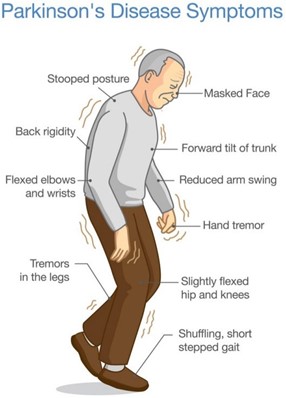A nurse is contributing to the plan of care for a client who has Parkinson's disease. Which of the following interventions should the nurse plan to include?
Restrict the client's fluid intake
Keep suction equipment at the client's bedside
Instruct the client to look down when ambulating
Position the client supine after eating
The Correct Answer is B
b. Keep suction equipment at the client's bedside.
The nurse should plan to include keeping suction equipment at the client's bedside as an intervention for a client with Parkinson's disease. Parkinson's disease can cause dysphagia (difficulty swallowing) and an increased risk of aspiration. Having suction equipment readily available allows for prompt intervention in case of choking or aspiration episodes, ensuring the client's safety.
Explanation for the other options:
a. Restrict the client's fluid intake: Restricting the client's fluid intake is not typically indicated in the care of a client with Parkinson's disease. Adequate hydration is important for overall health and well-being. However, specific fluid restrictions may be necessary in certain situations, such as if the client has coexisting conditions like heart failure or kidney disease, which should be assessed and determined by the healthcare provider.
c. Instruct the client to look down when ambulating: In Parkinson's disease, individuals often experience a forward-flexed posture and a shuffling gait. Instructing the client to look down when ambulating is not an appropriate intervention. Instead, the nurse should encourage the client to maintain an upright posture, take smaller steps, and focus on taking deliberate and controlled movements to promote stability and reduce the risk of falls.
d. Position the client supine after eating: Positioning the client supine after eating is not recommended for a client with Parkinson's disease. This position can increase the risk of aspiration, as it may promote reflux and regurgitation of stomach contents. Instead, the nurse should advise the client to maintain an upright position, such as sitting in a chair or using a recliner with appropriate head support, to aid digestion and reduce the risk of aspiration.

Nursing Test Bank
Naxlex Comprehensive Predictor Exams
Related Questions
Correct Answer is A
Explanation
a. Giving broad openings
The nurse is using the therapeutic technique of giving broad openings. This technique encourages the client to freely express themselves and choose the focus of the conversation. By asking, "What has been happening with you today?" the nurse is inviting the client to share their thoughts, feelings, and experiences without imposing any specific topic or direction.
Explanation for the other options:
b. Focusing: Focusing is a therapeutic technique where the nurse directs the conversation to a specific topic or issue. In this scenario, the nurse is not guiding the client's response toward a particular area of discussion.
c. Reflecting: Reflecting is a therapeutic technique where the nurse repeats or paraphrases the client's words or feelings to demonstrate understanding and encourage further exploration. The nurse's statement in this scenario does not involve reflecting the client's words or feelings.
d. Seeking clarification: Seeking clarification is a therapeutic technique used to obtain more specific information or clear up any confusion. The nurse's statement in this scenario does not involve seeking clarification from the client.
In summary, by using a broad opening, the nurse allows the client to choose the focus of the conversation
and encourages them to share their experiences and concerns.
Correct Answer is ["A","B","D","F"]
Explanation
Answer: A, B, D, F
Rationale:
A. "The ECT procedure will cause you to have a brief seizure.":
This statement is accurate as electroconvulsive therapy (ECT) intentionally induces a controlled seizure, which is thought to positively impact brain chemistry and alleviate symptoms of major depressive disorder. Educating the client about this aspect helps demystify the procedure and reduces anxiety.
B. "You will not be awake during the ECT procedure.":
The client receives general anesthesia before ECT, so they will be unconscious during the procedure. This reassurance can help alleviate fears associated with being awake and experiencing discomfort during the procedure.
C. "You will be placed on a ventilator to help you breathe during the ECT procedure.":
During ECT, clients do not require a ventilator, although they may receive oxygen support. An anesthetic and muscle relaxant are administered, and while the client’s breathing is closely monitored, a ventilator is unnecessary for this brief procedure.
D. "You will probably sleep the rest of the day following the ECT procedure.":
Many clients feel drowsy and need extra rest after ECT due to the effects of anesthesia and the brief seizure. Informing the client helps them prepare for this common effect and sets realistic expectations for their recovery period.
E. "It should only take one ECT treatment to bring you out of your depression.":
ECT is typically given as a series of treatments over several weeks to achieve lasting improvement in depressive symptoms. One treatment alone is usually insufficient, so this statement could mislead the client regarding the treatment plan.
F. "Some clients experience temporary memory loss following ECT therapy.":
Temporary memory loss, especially of recent events, is a known side effect of ECT. This side effect is generally transient but can help the client to be aware of this possibility, helping them to anticipate and manage any concerns post-treatment.
Whether you are a student looking to ace your exams or a practicing nurse seeking to enhance your expertise , our nursing education contents will empower you with the confidence and competence to make a difference in the lives of patients and become a respected leader in the healthcare field.
Visit Naxlex, invest in your future and unlock endless possibilities with our unparalleled nursing education contents today
Report Wrong Answer on the Current Question
Do you disagree with the answer? If yes, what is your expected answer? Explain.
Kindly be descriptive with the issue you are facing.
